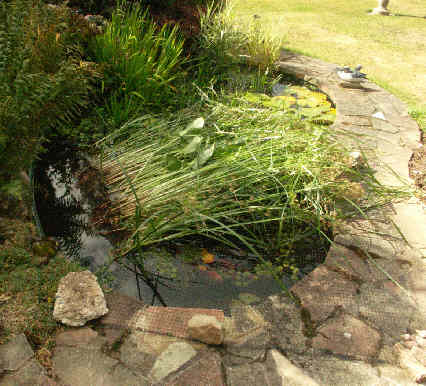 They absorb nutrients from the water and help keep the water clear by out-competing algae for these nutrients; they provide spawning sites for fish and amphibians and, in the case of flowering species, they look nice too!
They absorb nutrients from the water and help keep the water clear by out-competing algae for these nutrients; they provide spawning sites for fish and amphibians and, in the case of flowering species, they look nice too!It is advisable not to put any soil on the pond's base but plant all aquatic plants in suitable aquatic compost-filled baskets. This way, you will prevent plants spreading rampantly right across the pond and, if you don't like their original planting position you can move them to the more desirable spot easily.
WATER LILIES
 When you buy Water-lilies, they are, of necessity, small specimens and cannot be planted in a deep pond.
When you buy Water-lilies, they are, of necessity, small specimens and cannot be planted in a deep pond.
Plant them initially so that any existing leaves float on the water surface; stand their basket or pot on an upturned bucket or bricks to achieve this; gradually lower the lily into deeper water as it grows by removing some of the supports.
Aim to cover around one-third of the pond's water surface with Water-lilies to provide shade and reduce algae problems.
MARGINAL PLANTS
Marginal plants around the pond's circumference soften its edges and provide refuge for visiting animals and amphibians.
 Make sure that the marginal plants are those that like standing in water: simple, moisture-loving species may prefer a bog-garden situation.
Make sure that the marginal plants are those that like standing in water: simple, moisture-loving species may prefer a bog-garden situation.
Marginal plants come in many shapes and sizes. Some bush out to fill space and many have coloured flowers, others add height around the pond.
Tall grassy types may blow over into the pond in windy weather so make sure their baskets are well anchored.
FLOATING PLANTS
'Oxygenators' - around 2 clumps per square foot of water surface area - produce excess oxygen in the water during daylight but rampant growths can deplete oxygen levels during hot weather especially at night; provide extra aeration (leave the fountain on at night) to counteract this. Thin out oxygenators if necessary.
Start off oxygenators in warm shallow water to start with; lay them on the pond shelf for a period of time until they shows signs of growth before transferring them into deeper water. They do not need to be rooted in any substrate and can be left to float freely in the pond, where young fish can hide in them or adult fishes spawn in them.
FOOTNOTE: When choosing fish for the planted pond, all varieties of single-tailed Goldfish - Common Goldfish, Shubunkins and Comets are suitable. Koi have big appetites which generally includes plants!